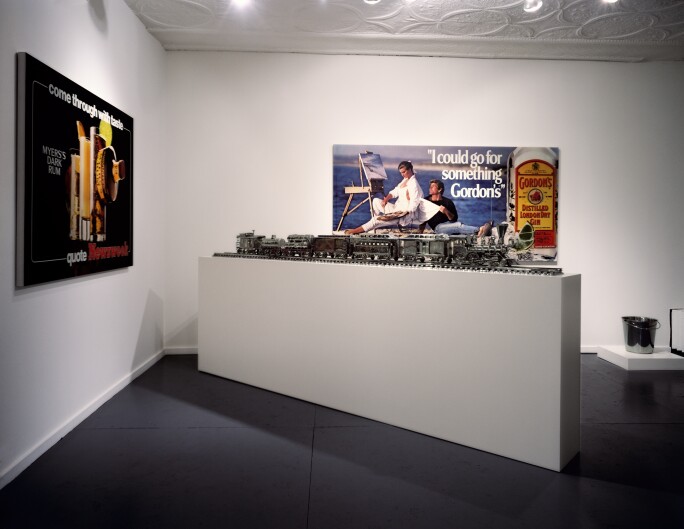“I was walking down Fifth Avenue and I saw in a liquor store this train that was made out of plastic and porcelain. It was a Jim Beam train. What caught my interest was the possibility to transform it and to cast it in stainless steel and bring it to a mirror finish, but also to maintain the soul of the piece, which was the liquor inside.”

Sold at Sotheby's New York, November 2021
傑夫・昆斯,《巴卡拉水晶酒具套裝》,1986年作
2021年11月售於紐約蘇富比
J eff Koons’s Jim Beam - J.B. Turner Engine (1986) is the archetypal example from the artist’s seminal Luxury and Degradation series, which saw Koons transform vernacular objects into stainless steel sculptures for the first time in his career. The Luxury and Degradation series was first exhibited at the International With Monument Gallery in New York and the Daniel Weinberg Gallery in Los Angeles in 1986, featuring his sparkling stainless steel sculptures from the series, including the Jim Beam - J.B. Turner Train. Koons’ transformation of the ceramic Jim Beam train decanter—was shown next to various bar accessories also cast in stainless steel—including Ice Bucket, Baccarat Crystal Set, Travel Bar and Fisherman Golfer, a cocktail shaker set—as well as replications of popular liquor advertisements for Bacardi Rum, Gordon’s Gin, Martell Cognac, Hennessy Whiskey and others.

Sold by Sotheby's New York, November 2011
傑夫・昆斯,《觀景車廂》,1986年,精鋼及波本酒,114.3 x 152.4 公分
2007年5月售於紐約蘇富比
For this iconic series, the artist created meticulous sculptures of the individual parts of the train, including the Jim Beam - Baggage Car, Barrel Car, Box Car, Caboose, Log Car, Observation Car, Passenger Car and the J.B. Turner Engine—as presented here—which arguably drives the point of Koons's artistic inquiry home. Each carriage, and the coveted Jim Beam - J.B. Turner Engine of which there are only three copies plus the Artist’s Proof, contains a fifth of bourbon that is sealed and tax-stamped, like the original Jim Beam train. In this way, Koons’s sculpture has gone through a material transformation, but “the soul of the piece, which is the liquor inside” is preserved (Jeff Koons cited in: Exh. Cat., San Francisco Museum of Modern Art, Jeff Koons: Retrospective, 1992, p. 65).

展覽圖片,洛杉磯,丹尼爾・溫伯格畫廊,「奢侈與墮落」,1986年
“By appropriating cheerful toys made to sell an addictive substance, Mr. Koons implicitly criticised a modern society rent by dependency on alcohol, drugs and other consumables like mass entertainment and fossil fuels. For some people, collecting art might be an addiction, and for them these train decanters could be pure crack. But alcohol and art can be spiritually elevating intoxicants, too. That ambiguity of the sacred and the profane would continue to animate Mr. Koons’s art over the next three decades”

展覽圖片,紐約,國際紀念畫廊,「奢侈與墮落」,1986年
Luxury and Degradation playfully yet powerfully highlights the danger of being manipulated and seduced by commerce and capitalism. Koons was struck by the way liquor advertisements at the time fed into and reinforced class stereotypes, with the content of the advertisements changing to target different audiences. Liquor advertisements aimed towards those of a higher socio-economic class were discernibly more abstract, monochromatic and conceptual, while those targeting a lower class were more narrative and figurative, selling a false promise of the American dream. Koons explained how his work played into yet at the same time critiqued the false luxury depicted in advertising, and the resulting dependence, much like alcoholism itself: “I wanted to show how luxury and abstraction are used to debase people and take away their economic and political power. The underlying theme paralleled the alcoholic… I worked in stainless steel. That was the first time I worked with it. It was perfect coordination because stainless steel was the only metal that would keep the alcohol preserved forever. But I also like the fake luxury of stainless steel. It has always been the luxury of the proletariat. It was to seduce” (Jeff Koons quoted in A. Haden-Guest, “Interview: Jeff Koons,” pp. 12-36, A. Muthesius (ed.), Jeff Koons, Cologne, 1992, pp. 20-21). Referred to by Koons as the “material of the Proletarian”, stainless steel is both practical and affordable, yet can be polished to a dazzling sheen that hints at luxury. However, as Koons powerfully symbolises with his work, it is a faux luxury, a false promise of the American dream.

「傑夫・昆斯回顧展」,龐畢度中心1號展廳,2014年11月26日至2015年4月27日
Jim Beam - J.B. Turner Engine is arguably one of the most significant works of Koons’s early career, as an inaugural example of the artist’s famous stainless steel sculptures, and an important, biting message satirising the world of faux luxury, false promises and the hard reality of alcoholism. In this work, Koons interrogates themes that would later become instrumental and archetypal to his widely-celebrated oeuvre, engaging with popular culture, the mass media, history and the concept of the readymade, redefining Pop Art and Minimalism using his own unique vision.